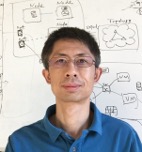This presentation will describe a DOE-funded research project, SENSE: SDN for End-to-end Networked Science at the Exascale. This project is led by the Energy Sciences Network (ESnet) and the project team includes Lawrence Berkeley National Lab, Caltech, Fermi National Accelerator Laboratory, Argonne National Laboratory, and University of Maryland/Mid-Atlantic Crossroads. The SENSE research project is building smart network services to accelerate scientific discovery in the era of 'big data' driven by Exascale, cloud computing, machine learning and AI. The project's architecture, models, and demonstrated prototype define the mechanisms needed to dynamically build end-to-end virtual guaranteed networks across administrative domains, with no manual intervention. In addition, a highly intuitive 'intent' based interface, as defined by the project, allows applications to express their high-level service requirements, and an intelligent, scalable model-based software orchestrator converts that intent into appropriate network services, configured across multiple types of devices. The significance of these capabilities is the ability for science applications to manage the network as a first-class schedulable resource akin to instruments, compute, and storage, to enable well defined and highly tuned complex workflows that require close coupling of resources spread across a vast geographic footprint such as those used in science domains like high-energy physics and basic energy sciences. The SENSE SC18 demonstration showcases a comprehensive approach to request and provision end-to-end network services across domains that combines deployment of infrastructure across multiple labs/campuses, SC booths and WAN with a focus on usability, performance and resilience through:
Slides not available for download yet
 Tom Lehman is the Director of Research at the University of Maryland
(UMD) / Mid-Atlantic Crossroads (MAX). His research and development
interests include advanced network architectures, intelligent control
planes, multi-layer inter-networking, network virtualization and
cloud computing. Mr. Lehman is responsible for developing research
programs and leading the research activities and associated technology
developments. Mr. Lehman has published over 30 research papers in related
areas. He has been Principal Investigator (PI) on multiple Defense
Advanced Research Projects Agency (DARPA), National Science Foundation
(NSF), and Department of Energy (DOE) projects. His previous research
projects have included the development of several open source software
products including the Dynamic Resource Allocation via GMPLS Optical
Networks (DRAGON) network control plane software, the Global Environment
for Network Innovations (GENI) Stitching Computation Service, and the
StackV orchestration system. His current research projects are focused
on development of technologies that facilitate the orchestration of high
performance network, computation, and storage resources in service of big
data driven domain science application workflows. Prior to joining MAX,
Lehman was a Computer Scientist and Project Leader at the University
of Southern California, Information Science Institute (USC/ISI) in
Arlington, Virginia.
Tom Lehman is the Director of Research at the University of Maryland
(UMD) / Mid-Atlantic Crossroads (MAX). His research and development
interests include advanced network architectures, intelligent control
planes, multi-layer inter-networking, network virtualization and
cloud computing. Mr. Lehman is responsible for developing research
programs and leading the research activities and associated technology
developments. Mr. Lehman has published over 30 research papers in related
areas. He has been Principal Investigator (PI) on multiple Defense
Advanced Research Projects Agency (DARPA), National Science Foundation
(NSF), and Department of Energy (DOE) projects. His previous research
projects have included the development of several open source software
products including the Dynamic Resource Allocation via GMPLS Optical
Networks (DRAGON) network control plane software, the Global Environment
for Network Innovations (GENI) Stitching Computation Service, and the
StackV orchestration system. His current research projects are focused
on development of technologies that facilitate the orchestration of high
performance network, computation, and storage resources in service of big
data driven domain science application workflows. Prior to joining MAX,
Lehman was a Computer Scientist and Project Leader at the University
of Southern California, Information Science Institute (USC/ISI) in
Arlington, Virginia.

Dr. Xi Yang is a Senior Research Scientist at University of Maryland (UMD) / Mid-Atlantic Crossroads (MAX). He is the Co-PI for several research projects funded by National Science Foundation and Department of Energy. His research activities and interests include advanced network architecture, next-generation Internet, optical networking, high-speed network control and management, network survivability and network security, large-scale network testbed and application, network middleware for e-Science applications, network virtualization and cloud computing. He has published over 30 research papers in related areas. He worked with Lucent Technologies as a member of technical staff in Bells Labs, Beijing, China in 2000. He joined University of Southern California (USC) / Information Sciences Institute (ISI) as a Research Associate in 2004 and became a Computer Scientist in 2006. He was the primary designer and developer for the widely used DRAGON network control plane software, the GENI Stitching Computation Service and the Internet2 ION GENI Aggregate Manager software. He helped develop the Internet2 DCN Software Suite and the ESnet OSCARS/IDC software. He is currently leading the development of the StackV orchestration system. He received a B.S. degree in communication engineering and an M.S. degree in communication and information systems from the University of Electronic Science and Technology, China in 1997 and 2000, and a Ph.D. degree in computer science from the University of Nebraska-Lincoln in 2004.